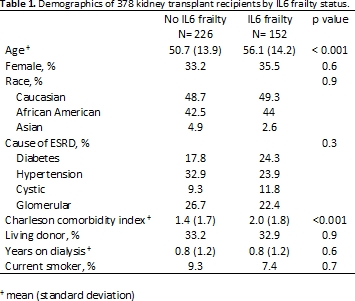Inflammatory Frailty Index and Mortality after Kidney Transplantation
Surgery, JHU, Baltimore.
Meeting: 2018 American Transplant Congress
Abstract number: 26
Keywords: Kidney transplantation
Session Information
Session Name: Concurrent Session: Kidney Deceased Donor Allocation - 1
Session Type: Concurrent Session
Date: Sunday, June 3, 2018
Session Time: 2:30pm-4:00pm
 Presentation Time: 2:30pm-2:42pm
Presentation Time: 2:30pm-2:42pm
Location: Room 6E
Frailty is a phenotype of decreased physiologic reserve and is associated with a pro-inflammatory state. Fried frailty (slow walk speed, weight loss, decreased grip, low activity, exhaustion) is associated with poor outcomes after kidney transplant (KT). However, Fried frailty does not directly capture inflammatory biomarkers, like IL6 and TNF-alpha, that are associated with increased post-KT mortality. We sought to identify a novel frailty index combining inflammatory markers and physical components.
METHODS: Fried frailty and inflammatory markers were collected for 378 KT recipients at Johns Hopkins Hospital upon KT admission enrolled in a prospective cohort (2009-2013). We evaluated novel inflammatory-frailty indices combining Fried frailty plus individual biomarkers (highest tertile of IL6, TNFa, HSCRP, inflammatory index). Scores for each novel index were 0-6, and ≥3 components was considered frail. We used Kaplan-Meier methods and Cox proportional hazards to assess mortality risk after KT.
RESULTS: 5-year survival for frail vs nonfrail patients: 81 vs 93% (IL6-frail), 87 vs 89% (HSCRP-frail), 83 vs 91% (TNFa-frail), 83 vs 91% (Inflamm index-frailty). After adjustment, mortality was 2.04-fold higher for IL6-frail recipients compared to nonIL6-frail (95%CI:1.02-4.10, p=0.05); there were no associations between mortality and other inflammatory-frailty indices. After adjustment, mortality was similar between nonfrail and frail KT recipients measured with Fried frailty (1.63,95%CI:0.75-3.51) and highest tertile of IL-6 (1.37,95%CI:0.68-2.73).
CONCLUSIONS: IL-6 frailty is a unique frailty phenotype, combining biomarkers and physical components that improves upon Fried frailty phenotype and is more strongly associated with post-KT mortality than either individual component. Measurement of biomarkers at KT evaluation and transplantation can guide risk assessment and patient counseling. 

CITATION INFORMATION: Haugen C., Ying H., McAdams-DeMarco M., Segev D. Inflammatory Frailty Index and Mortality after Kidney Transplantation Am J Transplant. 2017;17 (suppl 3).
To cite this abstract in AMA style:
Haugen C, Ying H, McAdams-DeMarco M, Segev D. Inflammatory Frailty Index and Mortality after Kidney Transplantation [abstract]. https://atcmeetingabstracts.com/abstract/inflammatory-frailty-index-and-mortality-after-kidney-transplantation/. Accessed December 16, 2025.« Back to 2018 American Transplant Congress
